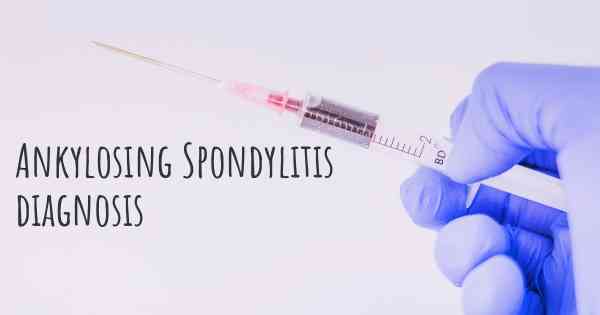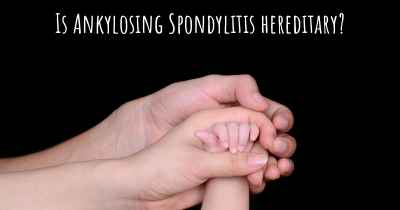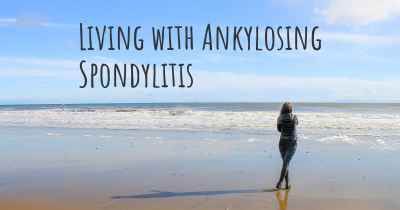4
How is Ankylosing Spondylitis diagnosed?
See how Ankylosing Spondylitis is diagnosed. Which specialists are essential to meet, what tests are needed and other useful information for the diagnosis of Ankylosing Spondylitis

For me it took 2 years of changes. Changing my meds, changing my diet, even buying a new bed. Then the x-rays and MRIs plus a blood test to see if I was HBL-27 positive.
Posted Mar 4, 2017 by Denise 450
Majority of people is still diagnosed too late, when the disease has already progressed, but pay attention if you have the following symptoms. And insist of getting an MRI done if nothing is shown on the X ray.
Symptoms
Early signs and symptoms of ankylosing spondylitis might include pain and stiffness in your lower back and hips, especially in the morning and after periods of inactivity. Neck pain and fatigue also are common. Over time, symptoms might worsen, improve or stop at irregular intervals.
The areas most commonly affected are:
The joint between the base of your spine and your pelvis (sacroiliac)
The vertebrae in your lower back
The places where your tendons and ligaments attach to bones (entheses), mainly in your spine, but sometimes along the back of your heel
The cartilage between your breastbone and ribs
Your hip and shoulder joints
When to see a doctor
Seek medical attention if you have low back or buttock pain that came on slowly, is worse in the morning or awakens you from your sleep in the second half of the night — particularly if this pain improves with exercise and worsens with rest. See an eye specialist (ophthalmologist) immediately if you develop a painful red eye, severe light sensitivity or blurred vision.
A rheumatologist is commonly the type of physician who will diagnose ankylosing spondylitis (AS), since they are doctors who are specially trained in diagnosing and treating disorders that affect the joints, muscles, tendons, ligaments, connective tissue, and bones.
Symptoms
Early signs and symptoms of ankylosing spondylitis might include pain and stiffness in your lower back and hips, especially in the morning and after periods of inactivity. Neck pain and fatigue also are common. Over time, symptoms might worsen, improve or stop at irregular intervals.
The areas most commonly affected are:
The joint between the base of your spine and your pelvis (sacroiliac)
The vertebrae in your lower back
The places where your tendons and ligaments attach to bones (entheses), mainly in your spine, but sometimes along the back of your heel
The cartilage between your breastbone and ribs
Your hip and shoulder joints
When to see a doctor
Seek medical attention if you have low back or buttock pain that came on slowly, is worse in the morning or awakens you from your sleep in the second half of the night — particularly if this pain improves with exercise and worsens with rest. See an eye specialist (ophthalmologist) immediately if you develop a painful red eye, severe light sensitivity or blurred vision.
A rheumatologist is commonly the type of physician who will diagnose ankylosing spondylitis (AS), since they are doctors who are specially trained in diagnosing and treating disorders that affect the joints, muscles, tendons, ligaments, connective tissue, and bones.
Posted Mar 4, 2017 by kat1 1050
To obtain a diagnosis of AS it is usually done by a Rheumatologist but other doctors could catch if they are familiar with autoimmune disorders. Bloodwork is typically done and there is a gene marker HLA-B27 that is significant for AS and usually hereditary. Just because you have the gene does not mean you have the active disease and you can also have it and not have the market. The Dr also does a physical exam and ask about symptoms and what you have and how long you have been dealing with them. They do Cray usually in the beginning as well especially if SI joints and hands looking for any fusion or damage that may/may not be showing yet. For treatment a Rheumatologist is usually who treats although you still follow with your pcp and sometimes pain management as well and if you have any other areas of concern you would follow that speciality Dr as well.
Posted Mar 5, 2017 by Heather 1120
MRI of spine and SI joints. Most diagnosed hla-b27 positive.
Posted May 17, 2017 by Shannon 1050
Typically patients see a rheumatologist for a reviewof their health history, family history, symptoms, and often imaging such as xrays and blood work to look for genetic markers and inflammation markers. The information helps the specialist evaluate your specific situation.
Posted May 17, 2017 by Keli 1050
Blood test and symptoms
Posted May 18, 2017 by Karlie 1150
Blood test X-ray specialists
Posted May 18, 2017 by kelly cannell 500
It is a combination of factors. Testing positive for the gene HLA-B27 can be a good indicator. Symptoms and evidence of damage seen on either X-rays or an MRI
Posted May 19, 2017 by Kylie Frost 2120
For me it is kind of a catch all diagnosis as I was damaged by Flouroquinelones (Cipro and Levaquin) so there is no real classification for us.
Posted May 19, 2017 by Tamra 1750
Blood tests, x-rays, MRIs and CT scans
Posted Aug 31, 2017 by BigStu111 12832
Having symptoms of low back and join pains, a positive reading of the HLA-B27 Gene though negative B27 readings can be confirmed with certain x-rays and targeted Cat Scans to inflammation of vertebra.
Posted Sep 6, 2017 by Daniel Wilson 2010
By MRI and x-ray is how it was diagnosed for me. Rheumatologist and a Pain Doctor is essential for us diagnosed. It depends on what the doctor finds needed as AS is not the same for everyone.
Posted Sep 7, 2017 by Luciano Scariano 2600
Blood tests
MRI
X-rays
Medical check
Medical performance tests
MRI
X-rays
Medical check
Medical performance tests
Posted Sep 7, 2017 by Carol 600
I underwent a myriad of blood work, MRIs and X-rays.
Posted Sep 10, 2017 by Sal 4050
Back Pain,Leg Pain,HLB-27,X-rays
Posted Sep 21, 2017 by Rana Navid Anwaar Khan 3945
Diagnosi con HLA
RISONANAZA magnetica
Raggi x
Ves
Pcr
Protidogramma
RISONANAZA magnetica
Raggi x
Ves
Pcr
Protidogramma
Posted Oct 1, 2017 by Silvia 2500
Nowadays when looking at the classification criteria for Ankylosing Spondylitis following the Assessement of Spondyloarthritis International Society, it almost look that it could be simple and quick.
Unfortunately, depending on so many factors as the health system of the country, doctors, patients, access to investigation and many other reason can lead to years of misdiagnose.
Doctors working with specialists as Rhumatologist are necessary.
Usually an X-Ray will be needed, but sadly only once the damaged are irreversible this way could help for diagnose, this is why in nowadays MRI are much more efficient to help early diagnose as they can help see inflammation at an early stage before bone ossification.
Also one of the criteria that can help is the test of the gene HLA-B27. If positive that can reinforce the supposition of the illness but it should by no means exclude the illness! As it is known by now that more than 100 genes can be related to AS and that many patients who have AS don't have HLA-B27.
But a few questions like:
did the pain last more than 3 months?
did it started before 45 years old?
did the pain get better or worse with exercice?
did the pain wakes up during the night?
did the pain came gradually over time?
Can already help to understand if the patient might be suffering from an inflammatory condition and help to actually take the right step towards the right direction for a diagnose.
Unfortunately, depending on so many factors as the health system of the country, doctors, patients, access to investigation and many other reason can lead to years of misdiagnose.
Doctors working with specialists as Rhumatologist are necessary.
Usually an X-Ray will be needed, but sadly only once the damaged are irreversible this way could help for diagnose, this is why in nowadays MRI are much more efficient to help early diagnose as they can help see inflammation at an early stage before bone ossification.
Also one of the criteria that can help is the test of the gene HLA-B27. If positive that can reinforce the supposition of the illness but it should by no means exclude the illness! As it is known by now that more than 100 genes can be related to AS and that many patients who have AS don't have HLA-B27.
But a few questions like:
did the pain last more than 3 months?
did it started before 45 years old?
did the pain get better or worse with exercice?
did the pain wakes up during the night?
did the pain came gradually over time?
Can already help to understand if the patient might be suffering from an inflammatory condition and help to actually take the right step towards the right direction for a diagnose.
Posted Feb 16, 2018 by Laeti 3570
A combination of signs, visualized by the health care provider, symptoms you report, as well as radiographs and a blood test called hla b27
Posted May 31, 2018 by Colleen 2550
Translated from portuguese
Improve translation
It is diagnosed after several tests, such as HLA-B27, blood tests, magnetic resonance imaging, and after these examinations, consultation with a rheumatologist.
Posted Aug 10, 2017 by Andressa 1050
Translated from portuguese
Improve translation
Diagnosis physical, rsonancia and analyze genetic
Posted Aug 14, 2017 by Luz 901
Translated from portuguese
Improve translation
Examinations through x-ray, magnetic resonance imaging, marker hla-b27, physical examination.
Posted Aug 15, 2017 by Adriana 1000








